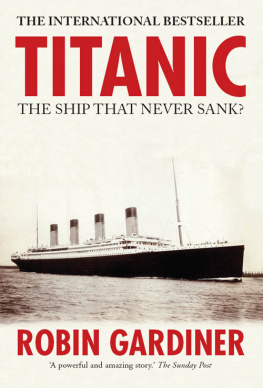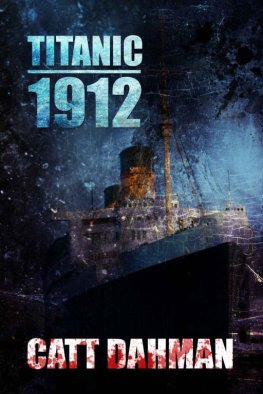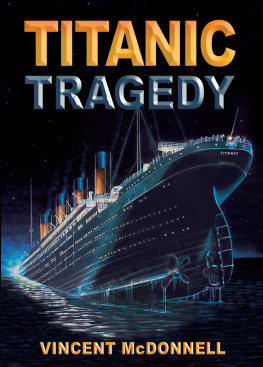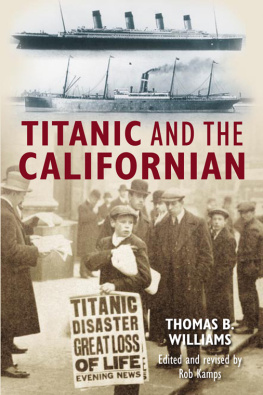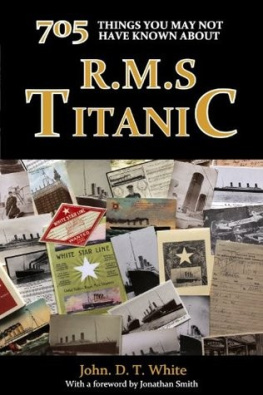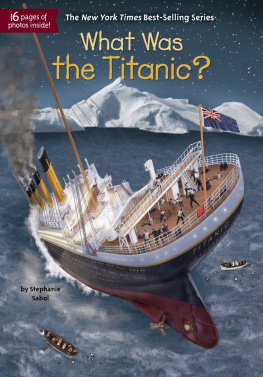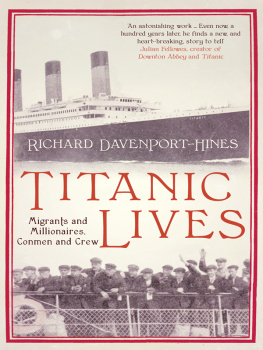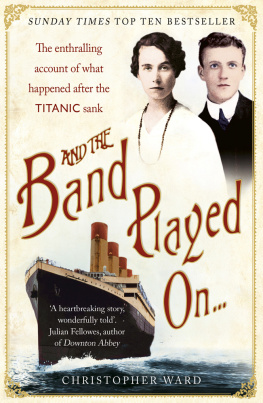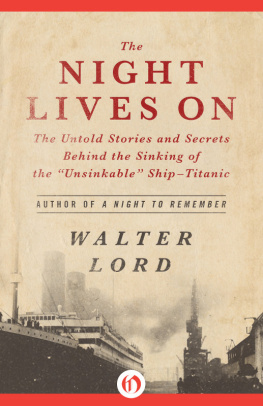TITANIC
THE SHIP THAT NEVER SANK?
ROBIN GARDINER

First published 1998 in hardback
Reprinted 1998
First paperback impression 2001
Reprinted 2003 and 2004
Second paperback impression 2009
ISBN 978 0 7110 3486 0
All rights reserved. No part of this book may be reproduced or transmitted in any form or by any means, electronic or mechanical, including photocopying, recording or by any information storage and retrieval system, without permission from the Publisher in writing.
Robin Gardiner 1998 / 2001 / 2009
The right of Robin Gardiner to be identified as the author of this work has been asserted in accordance with the Copyright Designs and Patents Act 1988 sections 77 and 78.
Published by Ian Allan Publishing
an imprint of Ian Allan Publishing Ltd, Hersham, Surrey KT12 4RG.
Printed and bound in the UK by CPI Mackays, Chatham ME5 8TD.
Code: 0910/C2
Please note that every effort has been made to contact all copyright holders to obtain necessary clearances for use of illustrations. Where this has not proved possible, the publishers will be happy to make any necessary corrections in subsequent impressions.
Acknowledgements
I would like to express my gratitude to all those authors whose published works provided such a welter of invaluable information, far too many to name here but who are listed in the Bibliography. It was these books, some of them written many years ago, that first aroused my interest in the loss of the Titanic. Another huge source of information was a transcript of the Board of Trade inquiry, taken by a Chamber of Commerce reporter in 1912, which was hunted down at the Bodleian Library by a most determined librarian, despite it being misfiled. Unfortunately I do not know the ladys name.
Many thanks to the people who have provided me with ideas or additional information: Arthur (Jack) Kimberley, Graham Barton, Rev Pat Thomas, Mrs Ann Robinson, Steve Hall, Robert McDougall, Miss J. Petrie, Patricia Meikle, Frank Sinclair, William Fong, Ian Church, Midori Brawn, to name but a few.
Although he was not involved in the writing of this book, my thanks to Dan van der Vat who, in the past, has given freely of his advice on style and presentation. I learned a lot from Dan. My thanks to Dinah Wiener for her continuing support.
Thanks to my friends who over the years have listened to my opinions, expressed their own views when they could get a word in, and kept me informed of newspaper articles, television programmes etc, particularly Roger, John, Derrick, Alan, Eric, Mick and Lis. And, of course, my wife Lynn and son Bill who have put up with the Titanic for longer than most people could stand.
Finally I would like to thank all those at Ian Allans who have made the publication of this book seem so easy.
Prologue
Even a cursory examination of the available evidence is enough to show that the story of the loss of the White Star liner Titanic, as we have been told it through the years, must be untrue. Just about all accounts tell of passengers and crew members being swept off the ship as she foundered, swimming about for up to a couple of hours and then spending up to another four hours standing on an upturned lifeboat. Nobody could have survived in the icy waters of the North Atlantic for as long as this group of Titanics survivors claimed. Maximum survival time in water as cold as that surrounding Titanic (-2C) is a very few minutes at best. It was this simple absurdity that first set me thinking that I might be looking at a cover-up.
As I delved deeper into the story, more and more inconsistencies became apparent. Inconsistencies that individually meant little but collectively pointed to a grimmer reality than that depicted in the usual heroic legend. Gone was the calm orderly evacuation of the sinking liner. Instead, a scene of chaos and discrimination emerged. It was no accident that a far higher percentage of first class passengers was saved than second class. Nor then did it come as any surprise to find that an even bigger discrepancy existed between those saved from second and third class.
Officers who were later acclaimed as heroes were exposed as anything but. One in particular removed a boy from a lifeboat, at gunpoint, before escaping in that same boat himself. Another told how he and his superior left the ship after being told by the captain to abandon their post. The timing of a wireless message received aboard another vessel in the general area proves without a doubt that this officer was lying. Yet another, ordered when he left in a lifeboat to stand close by the ship in order to pick people from the water after the ship foundered, promptly rowed away as fast as he could.
Descriptions of the collision and damage supposedly sustained by Titanic do not agree. The slight scrape with the ice that was hardly noticed by most aboard contradicts solid evidence of structural damage at least 5ft within the outer hull of the vessel.
Titanic carried a total of 20 lifeboats, four of them collapsibles which looked more like life-rafts. Three independent witnesses all described an extra lifeboat close to where the ship sank, one of them seeing this boat fairly soon after the collision. An extra lifeboat on the scene must have meant another ship was very close by.
Then came evidence to show that the ice the ship encountered was seen first not 500yd ahead but more like 11 miles. I began to wonder if perhaps the sinking of the Titanic might not have been an accident at all.
Preface
Many of you coming to this book will already have read The Riddle of the Titanic. However, for the benefit of those who havent, the basic arguments of that book are:
That the collision between HMS Hawke and RMS Olympic may have caused more serious damage to the liner than its owners were prepared to admit at the time.
That the inquiry, which automatically followed any collision involving a naval vessel, was not entirely unbiased.
That, as a result of the inquiry, the White Star line could not recover the cost of repairs to its ship from the insurance companies.
That, given the immense initial outlay in constructing Olympic and Titanic, and the amount of income lost by the formers two-month lay up following the Hawke incident, the owners and builders were left with serious financial problems.
That the owners, with the help of the builders, might have decided to switch the brand new Titanic with her slightly older sister in order to get at least one vessel back to sea and earning money.
That the owners, deciding that repair of the Olympic was uneconomic, might have resolved to dispose of the ship in such a way as to be able, this time, to collect on their insurance.
Although The Riddle of the Titanic is a serious and accurate account of events surrounding the loss of the Titanic, the theory of there having been a possible insurance fraud linked to the switching of the Titanic with her sister ship Olympic is to a great extent swallowed up by the sheer weight of other material in the book and has been deemed unlikely in light of what has become known as the 401 Test. However, since publication of The Riddle further research has shown that the 401 Test 401 being the Titanics build number is not the acid test it was once considered to be by some.
Since details of my hypothesis have been made public, I have been asked time and again, by readers, for more details of the switch theory and for another book on the same subject. With the benefit of new information, some of which came to light as a direct result of

